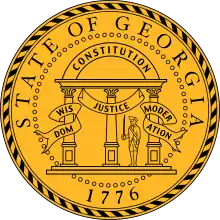| |||||||||||||||||||||||||||||||||||||||||||
| |||||||||||||||||||||||||||||||||||||||||||
 County results Talmadge: 20-30% 30-40% 40-50% 50-60% 60-70% 70-80% 80-90% Nix: 30-40% 40-50% 50-60% 60-70% 70-80% 80-90% Hardwick: 30-40% 40-50% 50-60% Holder: 30-40% 50-60% Edwards: 30-40% 60-70% Kelly: 50-60% | |||||||||||||||||||||||||||||||||||||||||||
| |||||||||||||||||||||||||||||||||||||||||||
| Elections in Georgia |
|---|
 |
The 1932 Georgia gubernatorial election took place on November 8, 1932, in order to elect the Governor of Georgia.
Incumbent Democratic Governor Richard Russell Jr. did not run for re-election to a second term, but instead ran for the U.S. Senate.
As was common at the time, the Democratic candidate ran unopposed in the general election so therefore the Democratic primary was the real contest, and winning the primary was considered tantamount to election.
Democratic primary
The Democratic primary election was held on September 14, 1932. As Talmadge won a majority of county unit votes, there was no run-off.
County unit system
From 1917 until 1962, the Democratic Party in the U.S. state of Georgia used a voting system called the county unit system to determine victors in statewide primary elections.[1]
The system was ostensibly designed to function similarly to the Electoral College, but in practice the large ratio of unit votes for small, rural counties to unit votes for more populous urban areas provided outsized political influence to the smaller counties.[2][3]
Under the county unit system, the 159 counties in Georgia were divided by population into three categories. The largest eight counties were classified as "Urban", the next-largest 30 counties were classified as "Town", and the remaining 121 counties were classified as "Rural". Urban counties were given 6 unit votes, Town counties were given 4 unit votes, and Rural counties were given 2 unit votes, for a total of 410 available unit votes. Each county's unit votes were awarded on a winner-take-all basis.[2][3]
Candidates were required to obtain a majority of unit votes (not necessarily a majority of the popular vote), or 206 total unit votes, to win the election. If no candidate received a majority in the initial primary, a runoff election was held between the top two candidates to determine a winner.[4]
Candidates
- H. B. Edwards
- Thomas W. Hardwick, former Governor
- John N. Holder, former chairman of the State Highway Commission[5] and unsuccessful candidate for Democratic nomination for governor in 1920 and 1926
- John I. Kelley
- Hosea Abit Nix, attorney[6]
- Hoke O'Kelley, businessman[7]
- F. B. Summers
- Eugene Talmadge, incumbent State Commissioner of Agriculture[6][8]
Results
| Candidate | Popular vote | County unit vote | ||
|---|---|---|---|---|
| Votes | % | Votes | % | |
| Eugene Talmadge | 116,381 | 42.02 | 264 | 64.39 |
| Hosea Abit Nix | 78,588 | 28.38 | 94 | 22.93 |
| Thomas W. Hardwick | 35,252 | 12.73 | 30 | 7.32 |
| John N. Holder | 19,697 | 7.11 | 10 | 2.44 |
| H. B. Edwards | 12,897 | 4.66 | 8 | 1.95 |
| John I. Kelley | 12,115 | 4.37 | 4 | 0.98 |
| Hoke O'Kelley | 1,823 | 0.66 | ||
| F. B. Summers | 197 | 0.07 | ||
| Total | 276,950 | 100.00 | 410 | 100.00 |
| Source: [9][10][11] | ||||
General election
In the general election, Talmadge ran unopposed.
Results
| Party | Candidate | Votes | % | ±% | |
|---|---|---|---|---|---|
| Democratic | Eugene Talmadge | 240,242 | 100.00% | ||
| Turnout | 240,242 | 100.00% | |||
| Democratic hold | Swing | ||||
References
- ↑ "County Unit System". Georgia County Clerks Association. Archived from the original on May 31, 2008. Retrieved June 8, 2020.
- 1 2 "Eugene Talmadge". The Jim Crow Encyclopedia. The African American Experience. Archived from the original on January 23, 2015. Retrieved August 12, 2013.
- 1 2 "County Unit System, eh?". Richard B. Russell Library for Political Research and Studies. October 6, 2011. Retrieved June 8, 2020.
- ↑ Buchanan, Scott (June 13, 2017). "County Unit System". New Georgia Encyclopedia. Retrieved June 8, 2020.
- ↑ History of Highway Construction in the State of Georgia and of the State Highway Board, 1916-1939 (PDF). Prepared by Division of Highway Planning of the State Highway Board of Georgia. 1939. p. 16.
- 1 2 "Lankford trails Dean". Evening Star. Washington, D.C. September 15, 1932. p. 1. Retrieved June 13, 2020.
- ↑ "Hoke O'Kelley Memorial Library". Emory University: History and Traditions. Retrieved June 13, 2020.
- ↑ Saye, Albert B. (1948). A Constitutional History of Georgia, 1732-1945. Athens, GA: University of Georgia Press. p. 379. ISBN 0-8203-3554-1.
- ↑ Congressional Quarterly 1998, p. 107.
- ↑ "GA Governor, 1932 - D Primary". Our Campaigns. Retrieved June 13, 2020.
- ↑ Georgia Register 1937, pp. 542–545.
- ↑ Congressional Quarterly 1998, p. 48.
- ↑ "GA Governor, 1932". Our Campaigns. Retrieved June 13, 2020.
- ↑ Glashan 1979, pp. 68–69.
- ↑ Georgia Register 1937, pp. 657.
Bibliography
- Gubernatorial Elections, 1787-1997. Washington, D.C.: Congressional Quarterly Inc. 1998. ISBN 1-56802-396-0.
- Glashan, Roy R. (1979). American Governors and Gubernatorial Elections, 1775-1978. Meckler Books. ISBN 0-930466-17-9.
- Compiled by Mrs. J.E. Hays, State Historian and Director (1937). Georgia's Official Register, 1933-1935-1937 (PDF). Atlanta, GA: State of Georgia, Department of Archives and History.



